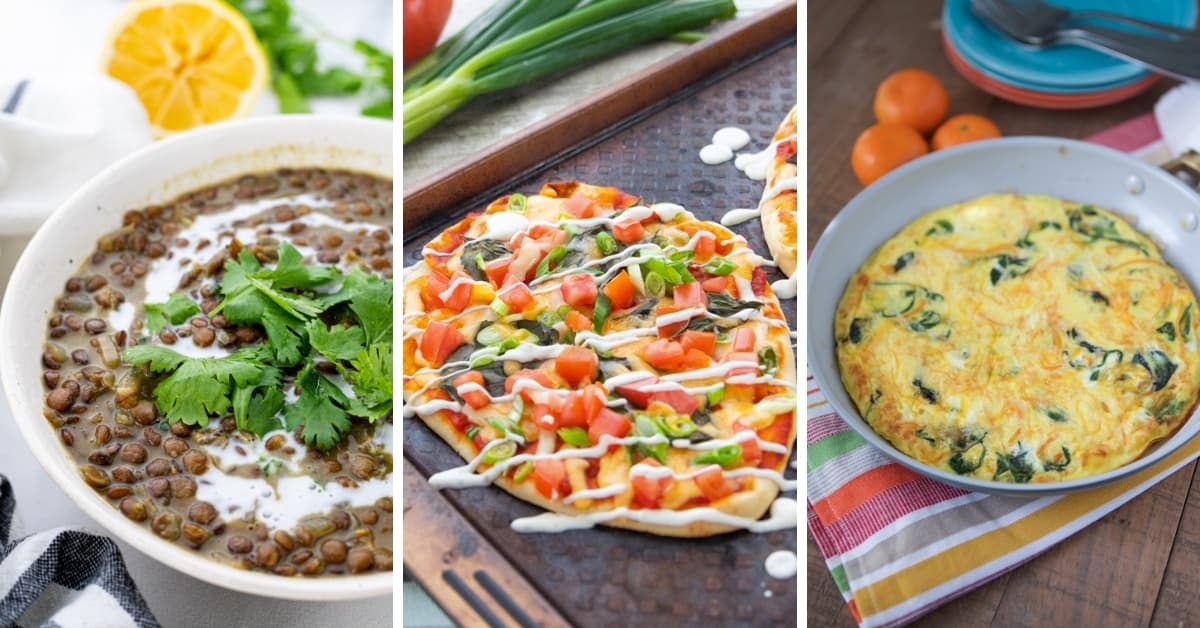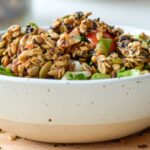Unlock a world of culinary creativity with this comprehensive guide to delicious, soy-free cooking! Discover vibrant flavors and satisfying textures as we explore a wealth of recipes and techniques designed to tantalize your taste buds without relying on soy-based ingredients. From hearty main courses bursting with fresh ingredients to subtly spiced side dishes and luscious desserts, we’ll equip you with the knowledge and inspiration to craft unforgettable meals that are both healthy and incredibly flavorful. Prepare to embark on a culinary journey that redefines the possibilities of soy-free cuisine.
This guide dives deep into the art of soy-free cooking, providing detailed recipes, insightful tips, and clever substitutions for soy-based products. Learn how to master flavorful marinades, create perfectly textured baked goods, and utilize diverse protein sources to build complete and balanced meals. We’ll explore various culinary traditions, showcasing the versatility and deliciousness of soy-free cooking, proving that it’s not just possible, but incredibly rewarding.
Soy-Free Sides and Sauces

Embarking on a soy-free culinary journey doesn’t mean sacrificing flavor or variety. In fact, eliminating soy opens up a world of exciting possibilities, allowing you to explore diverse flavor profiles and textures without relying on ubiquitous soy-based ingredients. This section will guide you through creating delicious and satisfying soy-free side dishes and sauces, highlighting the importance of balancing flavors and textures for a truly memorable dining experience.
Balancing flavors and textures is paramount when crafting soy-free accompaniments. A successful side dish or sauce should complement the main course without overpowering it. Consider contrasting textures – a creamy sauce against a crisp vegetable, for example – and layering flavors to create depth and complexity. Think about the overall taste profile of your meal; a rich, savory main course might pair well with a bright, acidic side, while a lighter dish might benefit from a richer, more decadent accompaniment.
Five Soy-Free Side Dish and Sauce Recipes
The following recipes showcase the versatility of soy-free cooking, drawing inspiration from various culinary traditions. Each recipe is designed to be easily adaptable to your preferences and available ingredients.
- Roasted Garlic and Herb Asparagus:
- Ingredients: 1 pound asparagus, 2 cloves garlic, 2 tablespoons olive oil, 1 teaspoon dried oregano, 1/2 teaspoon dried thyme, salt and pepper to taste.
- Steps: Preheat oven to 400°F (200°C). Toss asparagus with minced garlic, olive oil, oregano, thyme, salt, and pepper. Spread on a baking sheet and roast for 12-15 minutes, or until tender-crisp.
- Creamy Coconut Curry Cauliflower:
- Ingredients: 1 head cauliflower, 1 can (13.5 oz) full-fat coconut milk, 1 tablespoon curry powder, 1 teaspoon ginger, 1/2 teaspoon turmeric, salt and pepper to taste.
- Steps: Cut cauliflower into florets. Sauté ginger in a pan until fragrant. Add curry powder and turmeric, cook for 1 minute. Stir in coconut milk and cauliflower. Simmer until cauliflower is tender, about 15-20 minutes.
- Lemon-Herb Roasted Potatoes:
- Ingredients: 2 pounds small potatoes, 2 tablespoons olive oil, 1 lemon (zest and juice), 1 tablespoon fresh rosemary, 1 tablespoon fresh thyme, salt and pepper to taste.
- Steps: Preheat oven to 400°F (200°C). Toss potatoes with olive oil, lemon zest, lemon juice, rosemary, thyme, salt, and pepper. Roast for 30-40 minutes, or until golden brown and tender.
- Spicy Peanut Sauce (Soy-Free):
- Ingredients: 1/2 cup peanut butter (ensure soy-free), 2 tablespoons rice vinegar, 2 tablespoons lime juice, 1 tablespoon maple syrup, 1 tablespoon sesame oil, 1-2 teaspoons sriracha (or to taste), 1 clove garlic (minced).
- Steps: Whisk together all ingredients until smooth and creamy. Adjust sweetness and spice to your liking.
- Mediterranean Salsa Verde:
- Ingredients: 1 cup chopped parsley, 1/2 cup chopped cilantro, 1/4 cup capers, 2 cloves garlic (minced), 1/4 cup olive oil, 2 tablespoons red wine vinegar, salt and pepper to taste.
- Steps: Combine all ingredients in a bowl and mix well. This vibrant salsa is excellent served alongside grilled fish or chicken.
Creating a Flavorful Soy-Free Gravy
A rich and flavorful gravy elevates any meal. This step-by-step guide demonstrates how to create a delicious soy-free gravy, focusing on thickening techniques and flavorful spice combinations.
- Start with a flavorful base: Use pan drippings from roasted meats or sautéed vegetables. The natural flavors of these ingredients will form the foundation of your gravy.
- Deglaze the pan: Add a splash of broth (chicken, beef, or vegetable) to the pan to loosen any browned bits from the bottom. This adds depth and richness.
- Thicken the gravy: Several methods achieve a desirable consistency. A roux (equal parts butter and flour) is a classic choice. Alternatively, you can use cornstarch slurry (mix cornstarch with cold water) or arrowroot powder. Slowly whisk the thickening agent into the simmering gravy until it reaches your desired thickness.
- Season generously: Experiment with herbs and spices. A simple combination of salt, pepper, and a touch of thyme can be incredibly effective. For richer flavors, consider adding a bay leaf during simmering, removing it before serving.
- Simmer and adjust: Allow the gravy to simmer gently for a few minutes to allow the flavors to meld. Taste and adjust seasoning as needed, adding more salt, pepper, or herbs to achieve your desired flavor profile.
A well-made gravy should be smooth, flavorful, and perfectly complement the main dish. Don’t be afraid to experiment with different spice combinations to find your perfect blend.
Exploring Soy-Free Protein Sources
Finding delicious and nutritious protein sources without relying on soy is easier than you might think. Many excellent alternatives offer diverse flavors, textures, and nutritional benefits, catering to both vegetarian and non-vegetarian diets. This section explores three such options, detailing their culinary applications and nutritional value.
Alternative Protein Sources: Nutritional Benefits and Culinary Uses
Three excellent soy-free protein sources are lentils, quinoa, and chicken breast. Each provides a unique set of nutritional benefits and lends itself to a variety of culinary preparations.
Lentils, a humble legume, are packed with protein, fiber, and iron. Their earthy flavor pairs well with a wide range of spices and vegetables, making them a versatile ingredient in soups, stews, salads, and even veggie burgers. Imagine a vibrant lentil soup, its deep red hue hinting at the rich, savory broth within, speckled with tender lentils and aromatic herbs. The high fiber content contributes to digestive health, while the iron supports healthy blood production.
Quinoa, a complete protein meaning it contains all nine essential amino acids, is a nutritional powerhouse. Its slightly nutty flavor and fluffy texture make it a perfect substitute for rice or other grains. Picture a fluffy, pearly-white quinoa salad, tossed with chopped vegetables, herbs, and a light vinaigrette. The complete protein profile supports muscle growth and repair, while the fiber aids in digestion. Its versatility extends to breakfast bowls, stuffed peppers, and even as a base for hearty veggie burgers.
Chicken breast, a lean protein source, is a favorite among non-vegetarians. Its mild flavor absorbs marinades and seasonings beautifully, making it adaptable to countless dishes. Visualize a perfectly grilled chicken breast, its surface exhibiting a beautiful golden-brown char, its interior juicy and tender. The high protein content aids in muscle building and satiety, while being relatively low in fat. It can be incorporated into salads, stir-fries, tacos, and countless other recipes.
Cooking Methods and Texture Comparison
The cooking methods and resulting textures of these three protein sources differ significantly. Lentils require simmering in water or broth until tender, resulting in a soft, slightly creamy texture. Quinoa cooks similarly to rice, needing to be rinsed and simmered in water until fluffy. Its texture is light and airy, similar to couscous but with a more pronounced flavor. Chicken breast, on the other hand, can be cooked using various methods – grilling, pan-frying, baking, or poaching – resulting in textures ranging from crispy and charred to moist and tender. The choice of cooking method significantly influences the final texture and flavor profile of the chicken.
Incorporating Protein Sources into a Balanced Meal: A Recipe Example
This recipe combines the three protein sources into a single, balanced, and flavorful meal.
Mediterranean Quinoa Bowl with Lentils and Chicken
This vibrant bowl provides a complete protein profile, ample fiber, and a burst of Mediterranean flavors.
Ingredients:
* 1 cup quinoa, rinsed
* 1 cup green lentils, rinsed
* 1 boneless, skinless chicken breast, cut into bite-sized pieces
* 1 cucumber, diced
* 1 red bell pepper, diced
* 1/2 cup Kalamata olives, halved
* 1/4 cup crumbled feta cheese (optional)
* 2 tablespoons olive oil
* 1 tablespoon lemon juice
* 1 teaspoon dried oregano
* Salt and pepper to taste
Instructions:
1. Cook the quinoa and lentils according to package directions.
2. While the quinoa and lentils are cooking, season the chicken with salt, pepper, and oregano. Heat olive oil in a pan and cook the chicken until browned and cooked through.
3. In a large bowl, combine the cooked quinoa, lentils, and chicken.
4. Add the diced cucumber, red bell pepper, and olives.
5. Drizzle with lemon juice and olive oil.
6. Season with salt and pepper to taste.
7. Top with crumbled feta cheese (optional).
This recipe demonstrates the ease with which these diverse protein sources can be incorporated into a single, satisfying, and nutritionally balanced meal. The combination of textures and flavors creates a truly enjoyable and healthy eating experience.
Cooking delicious meals without soy doesn’t mean sacrificing flavor or variety; instead, it opens up a world of exciting culinary possibilities. By mastering the techniques and flavor combinations Artikeld in this guide, you’ll confidently create meals that are not only free of soy but also bursting with vibrant tastes and textures. So, embrace the challenge, experiment with new ingredients, and savor the joy of crafting unforgettable soy-free culinary masterpieces. The journey of culinary exploration awaits, filled with the promise of delicious discoveries!
FAQ
What are the best soy-free substitutes for soy sauce?
Coconut aminos, tamari (if gluten-free is not a concern), and Worcestershire sauce (check ingredients for soy) offer savory depth. Bragg Liquid Aminos are another popular choice.
Can I freeze soy-free meals?
Yes, many soy-free meals freeze well. Consider portioning them before freezing for easy reheating. Remember that freezing can alter textures slightly.
Are all soy-free products automatically gluten-free?
No. Always check ingredient labels as some soy-free products may contain gluten.
Where can I find soy-free baking ingredients?
Health food stores, specialty grocery stores, and online retailers are excellent sources for soy-free flours, baking powders, and other ingredients.


